Imagine pulling into your driveway and seeing a front yard that feels like a welcome mat for joy—colorful, inviting, and full of life. What if I told you achieving that doesn’t require a bank loan? More than 60% of home buyers say curb appeal is their first impression, yet many think beauty demands big budgets. But the truth? A well-designed flower bed can boost your home’s value by up to 8%, and you don’t need expensive plants or fancy tools to make it happen.
Let’s ditch the myth that cheap front yard flower bed ideas mean settling for mediocrity. With smart choices, a little creativity, and the right tips, your yard can shine without breaking the bank.
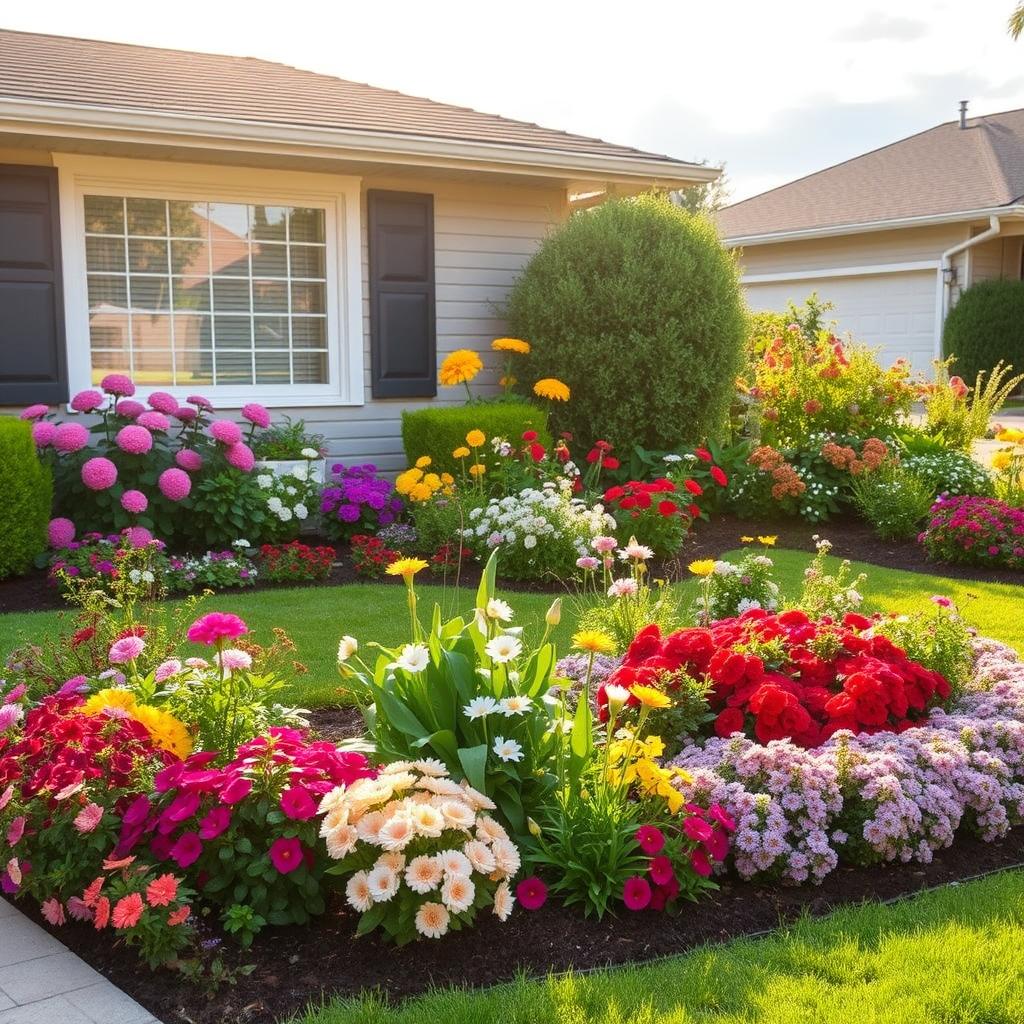
Picture this: a space where every dollar counts but every bloom still dazzles. Budget-friendly landscaping solutions aren’t about cutting corners—they’re about seeing potential in what you already have. Maybe you’ve hesitated to start because you thought “low cost” meant “low quality.” Let’s change that mindset.
This isn’t just about saving money; it’s about crafting a space that reflects your style while proving beauty and budget can coexist.
Key Takeaways
- Smart budget landscaping can increase home value by up to 8%.
- Cheap front yard flower bed ideas often use native plants that need less water and care.
- Creative reuse of materials like old tires or repurposed containers adds charm without spending.
- Planning ahead cuts costs by avoiding impulse buys and wasted supplies.
- Community swaps and end-of-season sales offer free or discounted plants.
Why Cheap Front Yard Flower Bed Ideas Don’t Mean Sacrificing Beauty
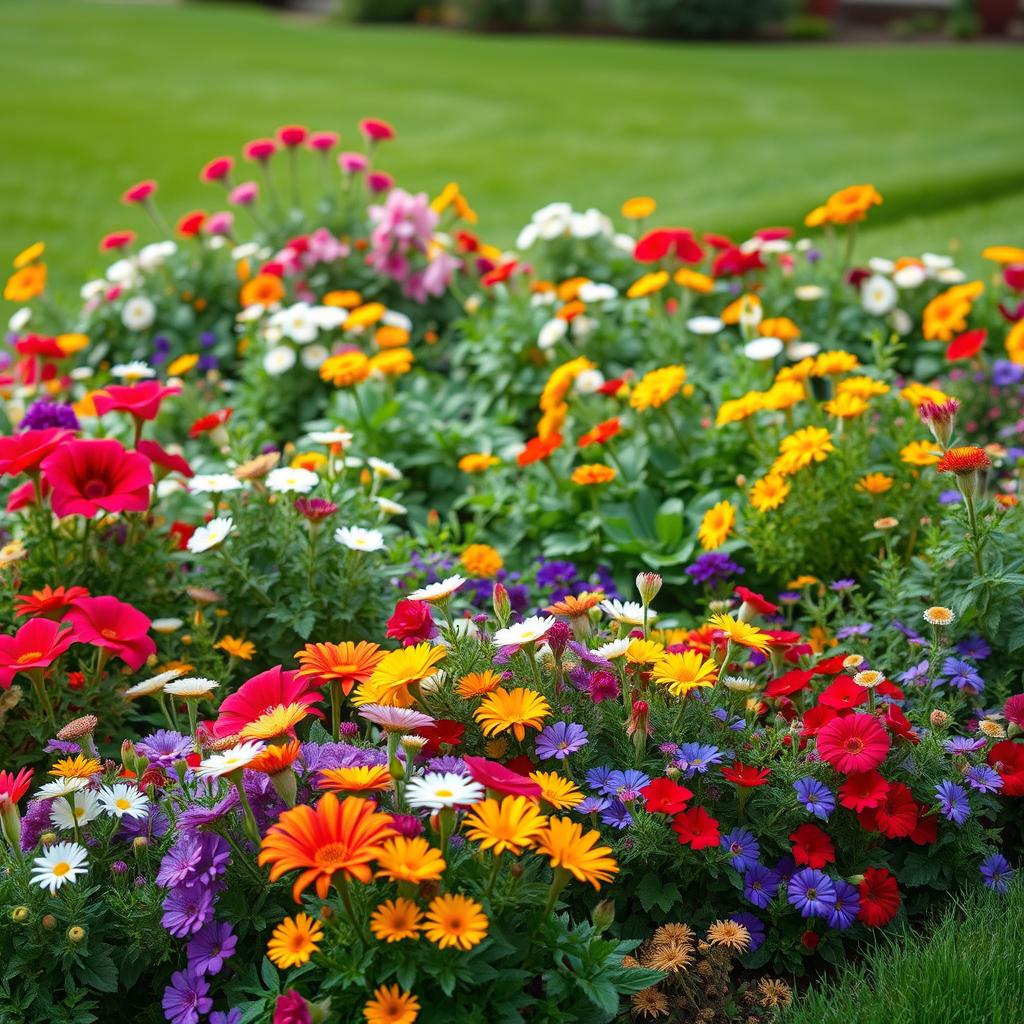
Many think cheap flower bed ideas mean they have to settle for less. But that’s not true. Even with a small budget, you can create stunning spaces that impress everyone. Let’s explore what’s really possible.
Common Misconceptions About Budget Landscaping
Myths like “cheap plants die fast” or “discount materials look cheap” stop people. But marigolds, for example, cost just $2 and bloom all summer. Reclaimed wood or stone alternatives under $10 add a unique touch. The Landscape Industry Council found 78% of buyers notice well-kept yards, no matter the cost.
The Psychology of Curb Appeal on a Budget
Small changes can make a big difference. A colorful container garden or a neat bed shows you care. Studies show homes with basic landscaping get 6-11% higher scores than those without.
Your front yard’s first 10 feet are key. Focus on that area for the best results.
Setting Realistic Expectations for Your Front Yard Transformation
- Under $100: Start with seasonal annuals in thrift-store pots. Add free mulch from tree services.
- Under $300: Install a raised bed using cinder blocks. Mix perennials like coneflowers for lasting color.
- Under $500: Create a pathway with stepping stones. Use native grasses that need minimal watering.
Every dollar counts when spent wisely. Choose plants that attract pollinators or add texture. Beauty isn’t about the budget—it’s about making smart choices that last.
Planning Your Low-Cost Front Yard Flower Beds
Smart planning makes your front yard dreams come true without breaking the bank. First, measure your space carefully to avoid wasting on soil, mulch, or plants. Use graph paper or apps like Garden Plan Pro to draw out economic garden bed layouts. Make sure they match your home’s style.
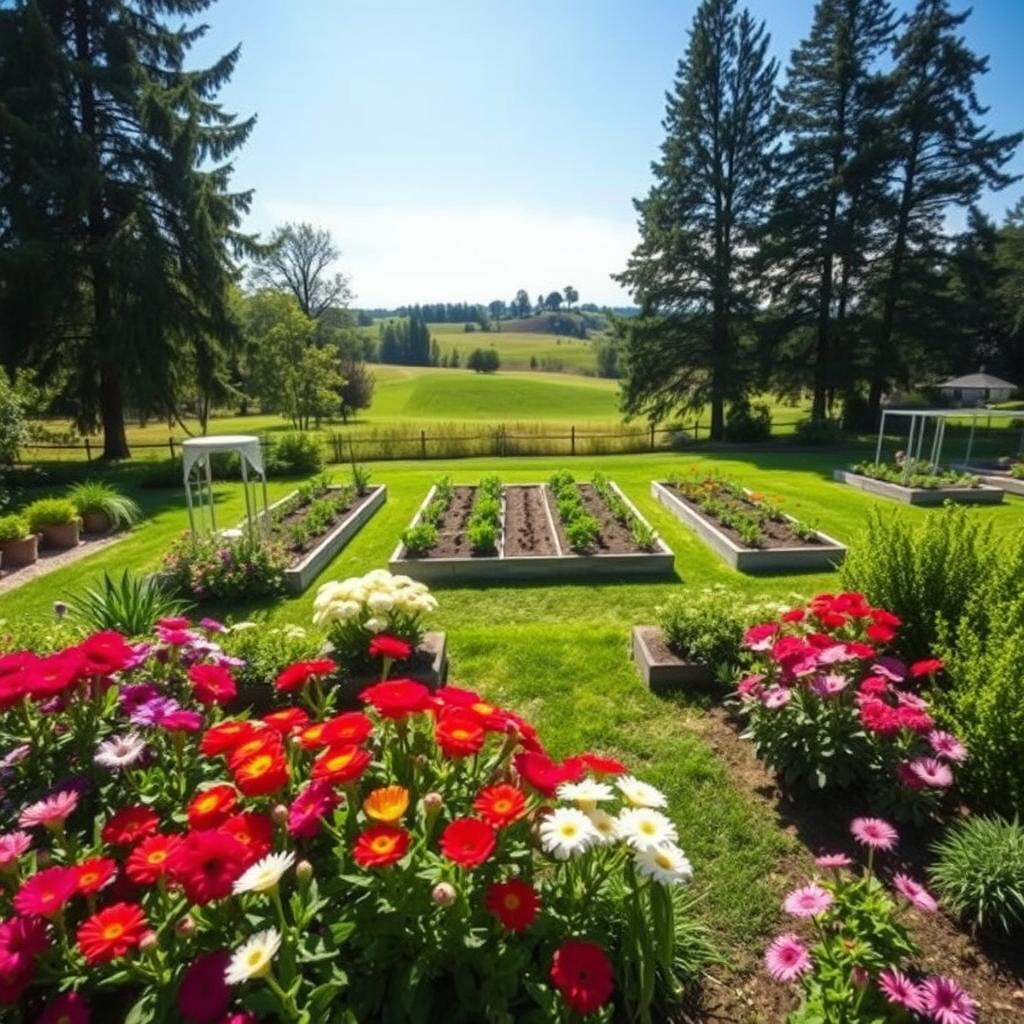
Then, check the sun and soil. See how sunlight hits your yard to pick the right plants. Use a cheap kit from Home Depot to test your soil pH. This helps prevent expensive plant failures.
- Sketch your yard’s dimensions and note sunny/shady zones
- Mark existing elements like walkways or trees to avoid collisions
- Research native plants suited to your soil conditions
Make a budget spreadsheet to track costs. Set aside 10-15% for a special item like a striking focal plant. Use low-cost gardening tips for the rest. Start with walkway borders and add more in phases.
“A well-planned layout saves twice as much as it costs.”
Use free resources like local cooperative extension guides. Choose plants that need the same water to simplify watering. This saves time and money by avoiding wrong choices.
Affordable Native Plants That Thrive With Minimal Care
Choosing the right plants is crucial for cheap front yard flower bed ideas that stay beautiful without spending a lot. Native and adaptable plants save on water, time, and replacements. Here’s how to pick plants that offer big beauty with little effort.
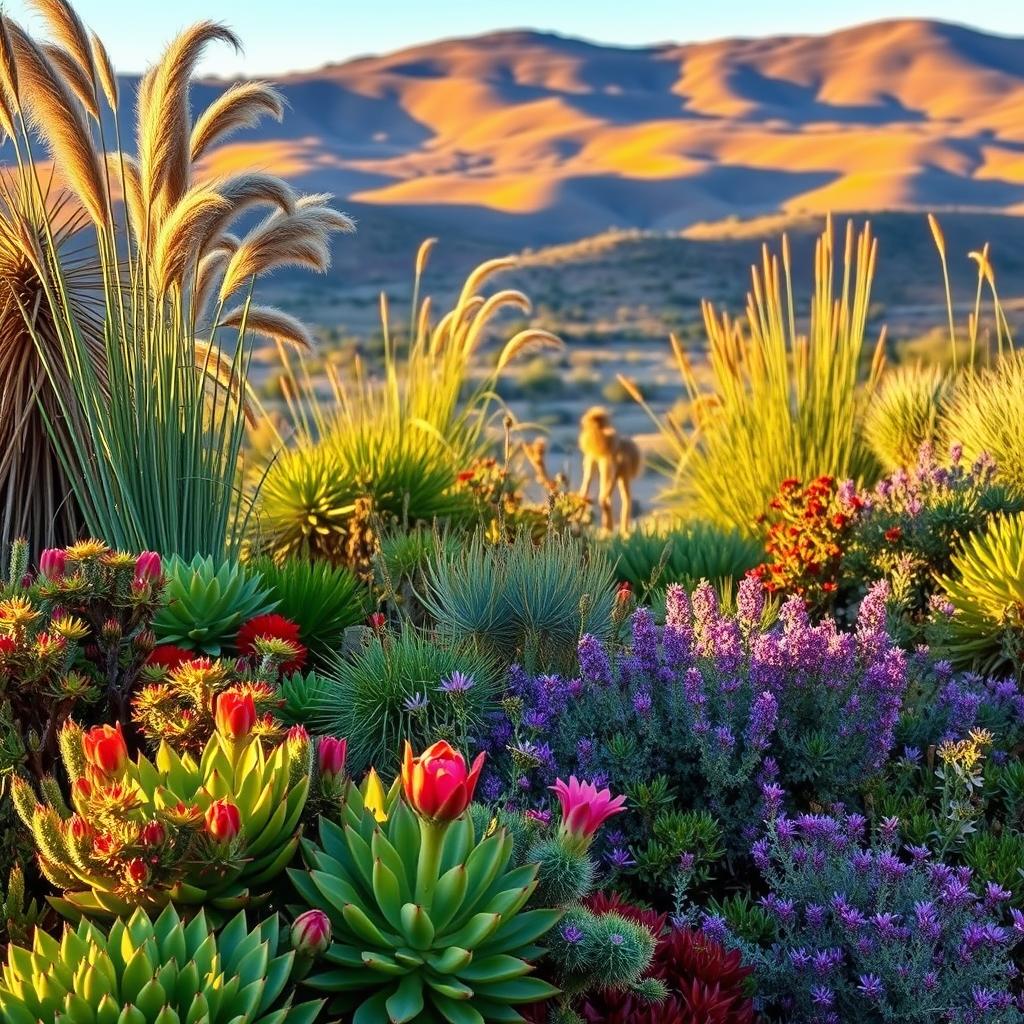
Drought-Tolerant Options That Save on Water Bills
Save money on water with plants that love dry weather. Try:
- Black-eyed Susans: Bright yellow blooms (USDA zones 3-9). $5-$8 per plant)
- Yarrow: Fern-like foliage with flower clusters (zones 3-8. $6-$10 per plant)
- Sedum: Succulent-like leaves in rock gardens (zones 3-11. $4-$7 per plant)
These plants need only 1″ of water weekly after planting. Use mulch to keep moisture in!
Perennials That Deliver Yearly Value
Invest in plants that come back every year to save money. Compare:
| Daylilies | $3-$6 per plant. Zones 3-9. Blooms for weeks |
| Coneflowers | $4-$9 per plant. Zones 3-8. Attracts pollinators |
| Hostas | $5-$12 per plant. Zones 3-9. Shade-friendly foliage |
These plants save $20-50 a year compared to replanting annuals every year.
Smart Annuals for Seasonal Pops
Add seasonal flair without overspending by:
- Buying packs of 12 marigolds ($3-$5) instead of single plants
- Clustering petunias ($2-$4 per pack) in focal points like walkways
- Choosing sunflowers ($1 seed packs) for bold color blocks
Focus blooms where they’ll make the biggest visual impact while keeping spending low.
DIY Flower Bed Borders That Won’t Break the Bank
Creating defined edges for your flower beds doesn’t have to cost a lot. These budget-friendly methods transform everyday items into stylish borders. They help you beautify your front yard without spending a lot.
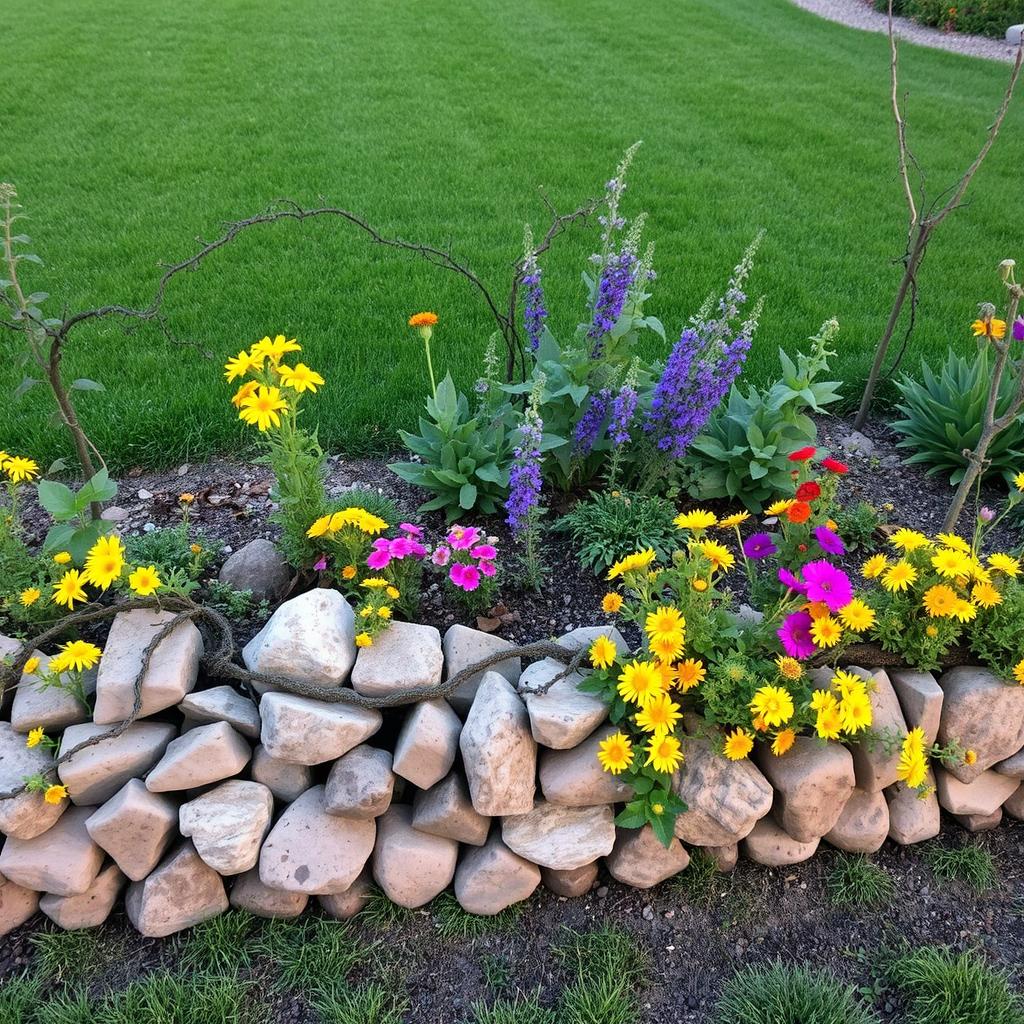
Upcycled Materials for Creative Edging
Turn items you already have into something new:
- Wine bottles cut into decorative shards (use safety precautions)
- Old bicycle wheels buried vertically as circular accents
- Pallet slats arranged in zigzag patterns
- Stacked fallen branches for rustic borders
Hold these materials in place with landscape staples or silicone adhesive. These options add beauty while being affordable.
Natural Stone Alternatives That Cost Less
| Material | Cost per linear foot | Pros |
|---|---|---|
| Brick pavers | $3–$6 | Reusable; withstands weather |
| River rocks | $2–$4 | Drainage-friendly; easy to adjust |
| Concrete blocks | $1.50–$3 | Stackable; holds soil well |
These options are cheaper than traditional stone, which costs $10–$15 per foot. They save money without losing style.
Simple Border Installation Techniques for Beginners
- Mark edges with spray paint or flour
- Excavate a 4–6 inch trench along the line
- Lay materials in desired pattern
- Backfill soil on both sides for stability
Use a level tool for even placement. No special skills are needed. Most projects can be done in under two hours!
Thrifty Mulch Alternatives for Weed Control and Moisture Retention
Mulch is key for healthy flower beds but doesn’t need to be pricey. Here are some low-cost gardening tips to protect your plants without spending a lot:
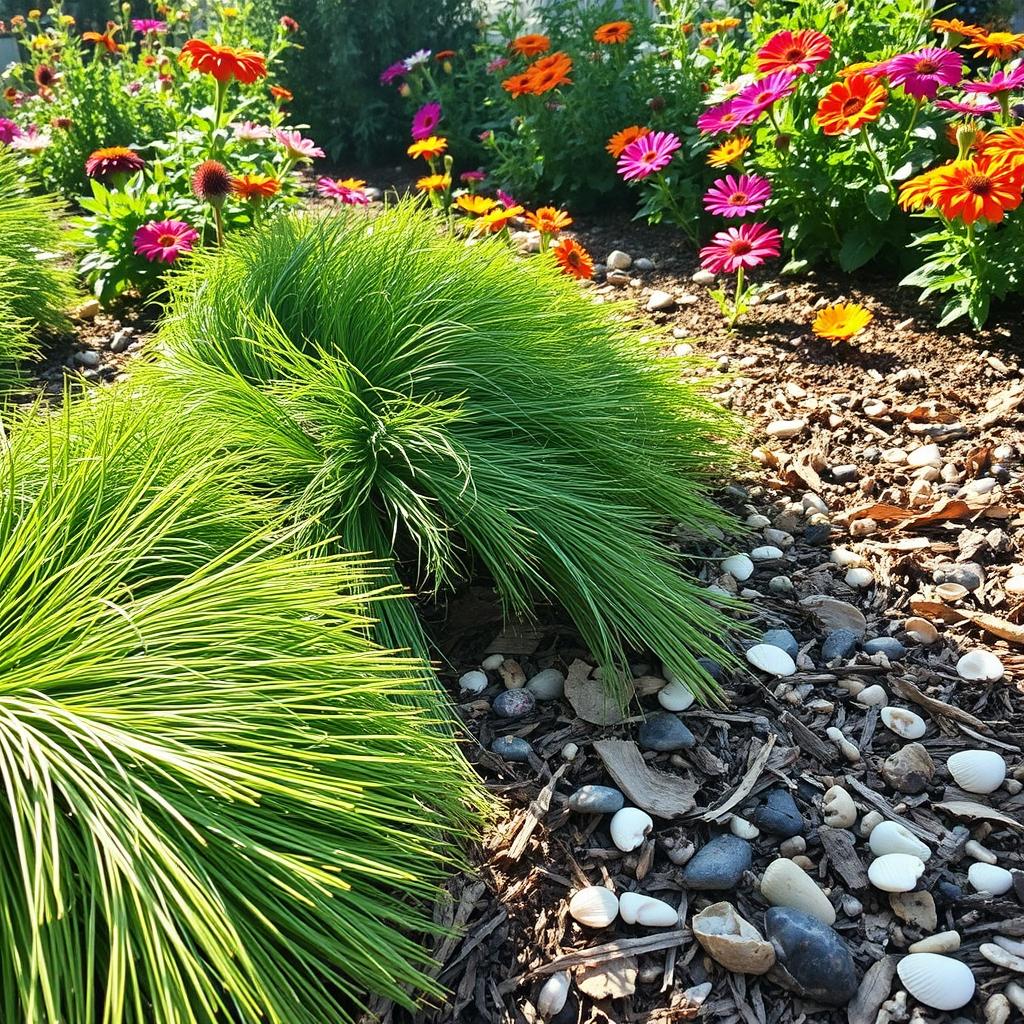
- Shredded leaves: Get them from your yard or neighbors. Spread 2-3 inches thick. It turns into nutrient-rich soil over time.
- Grass clippings: Collect after mowing or ask local law services. Make sure the grass isn’t treated with herbicides. Dry them before using.
- Newspaper: Put 6-8 sheets under bark mulch. Shred or soak it to keep it in place.
- Cardboard: Cut into pieces for garden paths. It’s great for keeping weeds down for a long time.
- Pine needles: Find them in local forests or get them from arborists. Acid-loving plants do well with this acidic mulch.
- Compost: Use homemade or free municipal compost. It improves soil health over time.
| Mulch Type | Cost | Longevity | Aesthetic |
|---|---|---|---|
| Shredded leaves | Free | 6-12 months | Earthy natural look |
| Newspaper | Free | 1-2 years under layers | Best hidden under decorative mulch |
| Cardboard | Free | 2+ years | Use in pathways or under plants |
| Pine needles | $0.50/lb (local discounts) | 2-3 years | Rustic texture contrast |
Many cities give away free mulch through parks departments or tree-trimming programs. Check with local arborists like Davey Tree or Bartlett Tree Experts—they often give away chipped branches. These frugal outdoor flower bed inspiration ideas can save you up to 90% compared to buying mulch. Mix different layers, like newspaper under pine needles, for the best results. Adjust based on your soil type and plant needs.
Repurposed Container Gardens to Enhance Your Front Yard
Turn everyday items into stunning containers for inexpensive floral arrangements. Using repurposed containers can make your affordable flower bed designs stand out. It’s a smart way to save money. Here’s how to get started:
Flea Market Finds That Make Perfect Planters
Look for unique containers at flea markets or garage sales. You might find:
- Weathered wooden crates ($5–$15)
- Rusty toolboxes ($10–$20)
- Abandoned wagons ($20–$30)
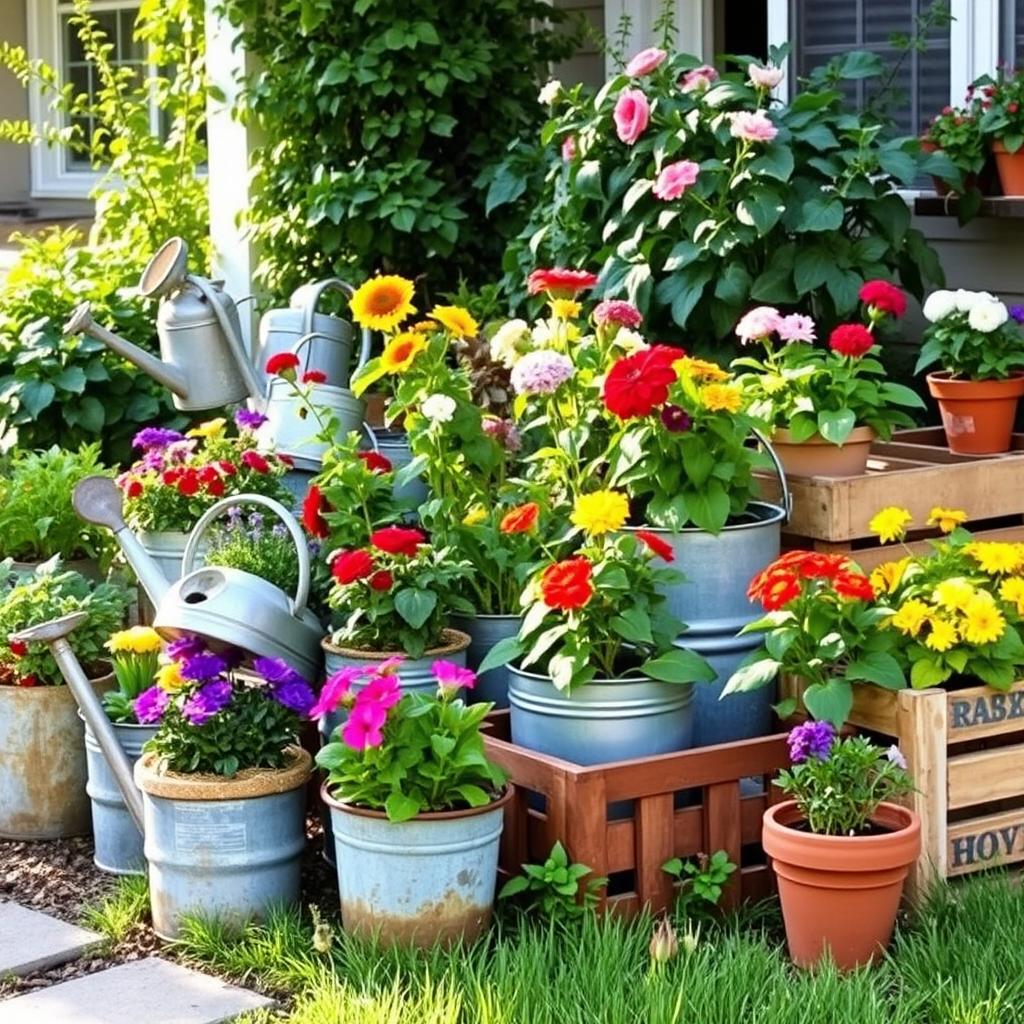
Household Items to Upcycle into Containers
Transform items you already have:
- Metal buckets: Drill holes for drainage and plant trailing flowers.
- Old boots: Fill with succulents for a fun touch.
- Ceramic shards: Make mosaic planters with waterproof sealant.
Choose lightweight soil mixes to avoid tipping.
Arranging Principles for Maximum Impact
| Principle | Example | Plant Suggestion |
|---|---|---|
| Odd numbers | Group 3 or 5 containers | Marigolds for bold color |
| Height contrast | Stack a tall urn with a short bowl | Lavender for structure |
| Color harmony | Pair blue tubs with purple flowers | Pansies for season-long bloom |
Change up your containers with the seasons. This way, you can refresh your look without buying new plants.
Cost-Effective Flower Bed Layouts That Maximize Impact
Smart design can make even small budgets look big. Whether your yard is small, shaded, or sloped, economic garden bed layouts can make a big impact without breaking the bank. Let’s look at cheap front yard flower bed ideas that focus on smart planning, not just spending.
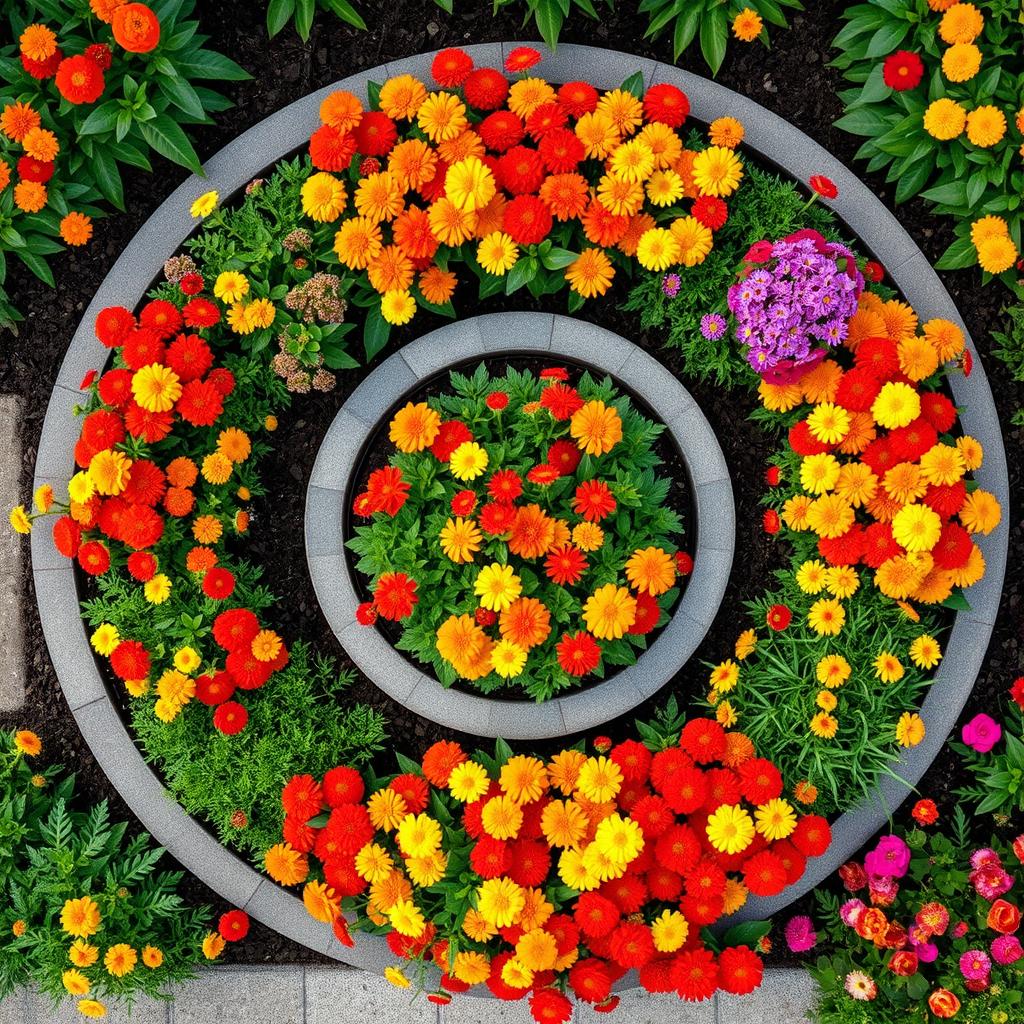
- Island beds: Centerpieces that draw eyes upward, ideal for open spaces
- Border beds: Frame walkways or driveways with minimal material use
- Curved edges: Soften lines without expensive stonework
| Type | Best For | Cost Impact | Visual Effect |
|---|---|---|---|
| Curved Borders | Narrow yards | $20-$50 | Softens sharp angles |
| Diagonal Layouts | Sloped lots | $30-$60 | Reduces erosion visually |
| Grid Patterns | Shaded areas | $15-$35 | Creates order with limited plants |
Use threes or fives for plant groupings to create unity. Place taller plants at corners or ends to guide the eye. A 4x6ft bed with three plant groupings can cost $40 but looks like $150 when planned well. Empty spaces between plants make colors stand out without spending more.
Try these ideas to stretch your budget. Small changes in shape or plant placement can transform your front yard into a memorable space.
Money-Saving Maintenance Tips to Keep Your Flower Beds Looking Fresh
Keep your garden thriving without overspending. These thrifty floral garden ideas focus on smart upkeep that saves time and money.
DIY Fertilizers and Plant Foods
Transform kitchen scraps into free plant food:
- Eggshells: Crush and sprinkle around plants for calcium.
- Coffee grounds: Mix into soil for nitrogen boost (use in moderation).
- Banana peels: Blend into compost or bury near plant roots.
These homemade mixes cut costs by 90% compared to store-bought options, supporting cost-effective front yard beautification.
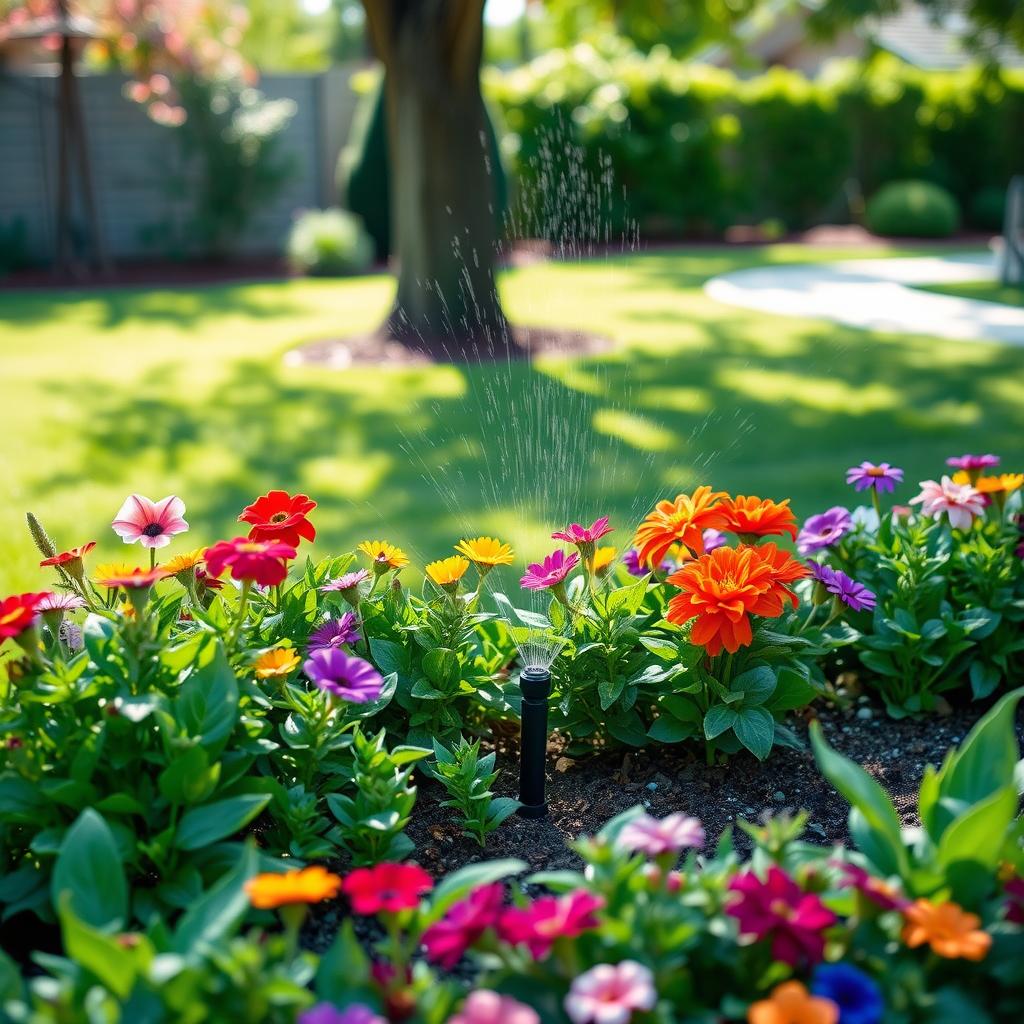
Smart Watering Systems on a Shoestring Budget
Create efficient irrigation without big investments:
- Reuse plastic bottles as drip emitters: Poke holes in the bottom and bury halfway.
- Install a rain barrel to capture free water for irrigation.
- Mulch beds with shredded leaves to retain moisture and reduce evaporation.
Seasonal Care That Prevents Costly Replacements
Avoid plant loss with this seasonal calendar:
| Month | Action |
|---|---|
| March | Divide overgrown perennials to propagate free plants. |
| June | Mulch beds to suppress weeds naturally. |
| September | Apply compost tea as organic pest deterrent. |
| December | Protect tender plants with burlap wraps. |
Regular care prevents the need for costly replanting, extending your thrifty floral garden ideas into every season.
Where to Find Free or Cheap Plants for Your Front Yard
Starting with inexpensive floral arrangements means finding plants on a budget. Here’s how to garden without spending too much:
Community Plant Swaps and Garden Club Benefits
Join local plant swaps or garden clubs to trade plants. Many neighborhoods have spring and fall swaps. Check Facebook groups or community boards. Benefits include:
- Free plants from neighbors
- Networking with fellow gardeners
- Learning low-cost gardening tips from experts
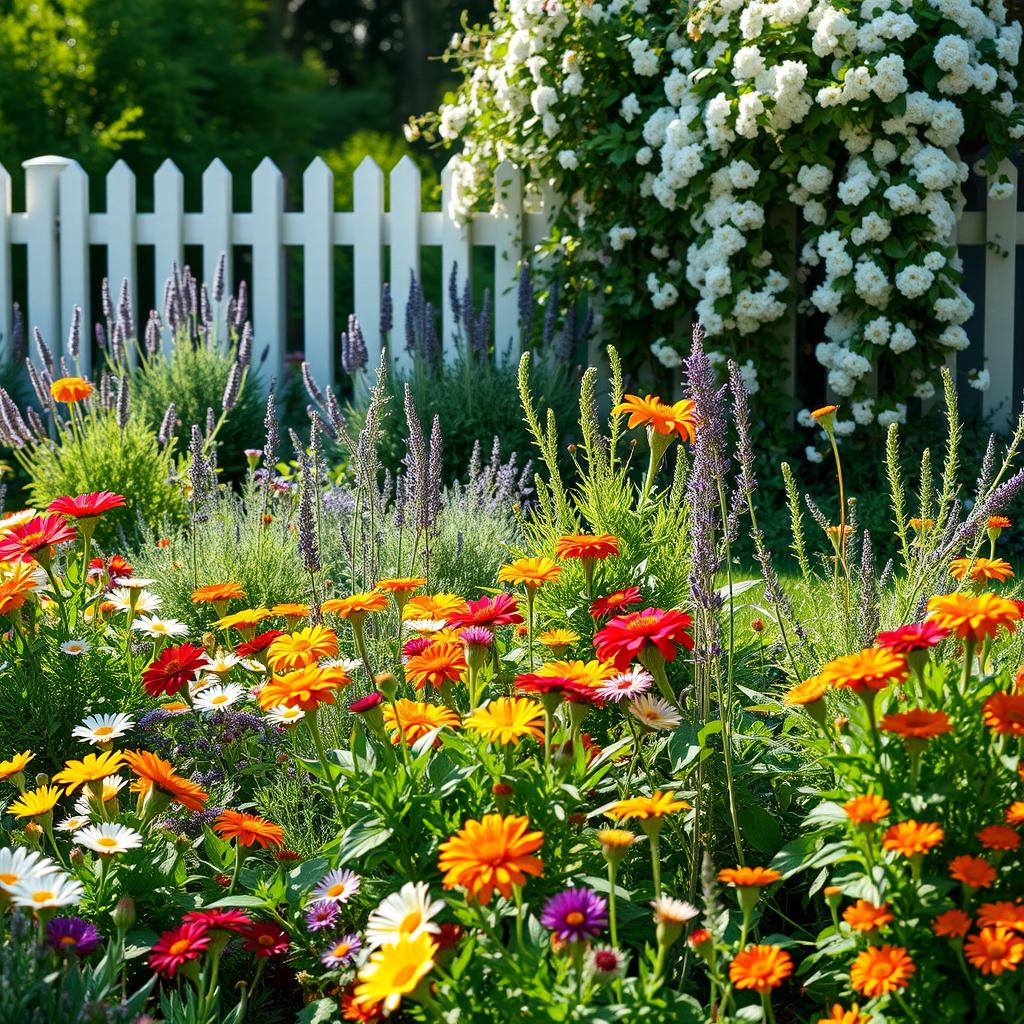
End-of-Season Sales and Clearance Strategies
Garden centers like Home Depot or Walmart offer big discounts in fall. Look for:
- Root check: Healthy roots mean discounted plants still thrive
- Negotiate: Ask for bulk discounts when buying 10+ plants
- Ugly but viable: Yellowing leaves might hide hardy specimens
Propagation Techniques to Multiply Your Plants
Grow more plants from existing ones using:
- Stem cuttings: Snip 4-inch tips from hydrangeas or succulents
- Division: Split overgrown hostas every 3 years
- Seed saving: Collect marigold seeds after blooms fade
“Propagation turns one plant into ten—nature’s best budget hack.” – Sarah Green, Urban Gardening Advocate
Conclusion: Creating Beautiful Front Yard Flower Beds Doesn’t Require a Hefty Investment
Turning your front yard into a beauty spot doesn’t need to cost a lot. This guide shows that budget-friendly landscaping solutions can lead to amazing results. By picking native plants and using recycled materials, you can make affordable flower bed designs that look great.
Look at how people have made their yards look amazing with little money. They’ve used old containers and gotten free plants from swaps. Even small changes, like adding drought-tolerant flowers, can make a big difference.
Start small, like adding stones to a flower bed or using plants from a flea market. Every little bit helps.
Beauty is about making smart choices, not just spending money. Check out your local nursery’s clearance section and join a garden club. You can also grow plants from cuttings from friends. These steps save money and help your community. Plus, plants that need less water are good for your wallet and the planet.
Begin with something simple, like drawing a small design or going to a plant exchange. Share your journey on social media with #BudgetLandscaping. Every garden starts with one seed. Start today and watch your front yard flourish without breaking the bank.
FAQ
What are some cheap front yard flower bed ideas that are easy to implement?
There are many budget-friendly ways to landscape your front yard. Try using native plants, which need less care. You can also make borders with old bricks or wooden pallets.
Planting perennials is another smart choice. They bloom every year without needing to be replanted often.
How can I achieve a beautiful front yard without exceeding my budget?
Begin by planning your flower bed designs wisely. Focus on areas that get a lot of attention. Measure your space well and pick plants that do well in your climate.
DIY borders with recycled materials or natural stones are also cost-effective. They add beauty without spending a lot.
Are there effective ways to maintain flower beds on a budget?
Yes, there are! Make your own fertilizers from kitchen scraps. This is a cheap way to feed your plants.
Consider DIY watering systems like rain barrels. They save money and are good for the environment. Regular care keeps your beds looking great without expensive products.
Where can I find inexpensive floral arrangements for my front yard?
Local garden clubs and community plant swaps are great places to find plants for free or cheap. Look for end-of-season sales at garden centers too. You can find amazing deals on plants to beautify your yard.
How can I make the most of my front yard with cost-effective designs?
Focus on layouts that save money but look great. Try curving edges or group plants in interesting ways. Using fewer varieties but showing them well can create a beautiful look.